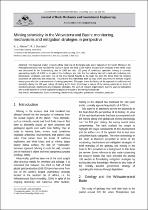 ResearchSpace
ResearchSpace
Mining seismicity in the Witwatersrand Basin: monitoring, mechanisms and mitigation strategies in perspective
JavaScript is disabled for your browser. Some features of this site may not work without it.
- ResearchSpace
- →
- Research Publications/Outputs
- →
- Journal Articles
- →
- View Item
| dc.contributor.author |
Riemer, KL

|
|
| dc.contributor.author |
Durrheim, RJ

|
|
| dc.date.accessioned | 2012-10-23T11:59:28Z | |
| dc.date.available | 2012-10-23T11:59:28Z | |
| dc.date.issued | 2012-06 | |
| dc.identifier.citation | Riemer, KL and Durrheim, RJ. 2012. Mining seismicity in the Witwatersrand Basin: monitoring, mechanisms and mitigation strategies in perspective. Journal of Rock Mechanics and Geotechnical Engineering, vol. 4(3), pp. 228-249 | en_US |
| dc.identifier.issn | 1674-7755 | |
| dc.identifier.uri | http://www.rockgeotech.org/qikan/manage/wenzhang/2012-03-04.pdf | |
| dc.identifier.uri | http://hdl.handle.net/10204/6209 | |
| dc.description | Copyright: 2012 Journal of Rock Mechanics and Geotechnical Engineering | en_US |
| dc.description.abstract | The Kaapvaal Craton in South Africa hosts one of the largest gold placer deposits in the world. Mining in the Witwatersrand Basin here has been the source of about one third to one half of the gold ever produced in the world. Gold was discovered in the Johannesburg area in 1886 and after 120 years of continuous operation, mining is currently approaching depths of 4 000 m. In spite of the challenges and risks that the industry has had to deal with including rock temperature, ventilation and water, one of the most feared hazards in the basin has been the threat from the ongoing occurrence of seismicity and rockbursts. The problem first manifested itself by way of the occurrence of tremors roughly twenty years after the commencement of mining operations. This paper traces the history of the approach to rockbursts and seismicity during the 120 year history of mining in the basin. It portrays a picture of the mining seismicity in terms of monitoring phases, mechanisms and mitigation strategies. The work of research organizations over the years is highlighted with a brief mention of current regulation strategies on the part of the mining inspectorate. | en_US |
| dc.language.iso | en | en_US |
| dc.publisher | Institute of Rock and Soil Mechanics, Chinese Academy of Sciences | en_US |
| dc.relation.ispartofseries | Workflow;9648 | |
| dc.subject | Witwatersrand Basin | en_US |
| dc.subject | Kaapvaal Craton | en_US |
| dc.subject | Gold mining | en_US |
| dc.subject | Rockbursts | en_US |
| dc.subject | Seismicity | en_US |
| dc.subject | Mining operations | en_US |
| dc.title | Mining seismicity in the Witwatersrand Basin: monitoring, mechanisms and mitigation strategies in perspective | en_US |
| dc.type | Article | en_US |
| dc.identifier.apacitation | Riemer, K., & Durrheim, R. (2012). Mining seismicity in the Witwatersrand Basin: monitoring, mechanisms and mitigation strategies in perspective. http://hdl.handle.net/10204/6209 | en_ZA |
| dc.identifier.chicagocitation | Riemer, KL, and RJ Durrheim "Mining seismicity in the Witwatersrand Basin: monitoring, mechanisms and mitigation strategies in perspective." (2012) http://hdl.handle.net/10204/6209 | en_ZA |
| dc.identifier.vancouvercitation | Riemer K, Durrheim R. Mining seismicity in the Witwatersrand Basin: monitoring, mechanisms and mitigation strategies in perspective. 2012; http://hdl.handle.net/10204/6209. | en_ZA |
| dc.identifier.ris | TY - Article AU - Riemer, KL AU - Durrheim, RJ AB - The Kaapvaal Craton in South Africa hosts one of the largest gold placer deposits in the world. Mining in the Witwatersrand Basin here has been the source of about one third to one half of the gold ever produced in the world. Gold was discovered in the Johannesburg area in 1886 and after 120 years of continuous operation, mining is currently approaching depths of 4 000 m. In spite of the challenges and risks that the industry has had to deal with including rock temperature, ventilation and water, one of the most feared hazards in the basin has been the threat from the ongoing occurrence of seismicity and rockbursts. The problem first manifested itself by way of the occurrence of tremors roughly twenty years after the commencement of mining operations. This paper traces the history of the approach to rockbursts and seismicity during the 120 year history of mining in the basin. It portrays a picture of the mining seismicity in terms of monitoring phases, mechanisms and mitigation strategies. The work of research organizations over the years is highlighted with a brief mention of current regulation strategies on the part of the mining inspectorate. DA - 2012-06 DB - ResearchSpace DP - CSIR KW - Witwatersrand Basin KW - Kaapvaal Craton KW - Gold mining KW - Rockbursts KW - Seismicity KW - Mining operations LK - https://researchspace.csir.co.za PY - 2012 SM - 1674-7755 T1 - Mining seismicity in the Witwatersrand Basin: monitoring, mechanisms and mitigation strategies in perspective TI - Mining seismicity in the Witwatersrand Basin: monitoring, mechanisms and mitigation strategies in perspective UR - http://hdl.handle.net/10204/6209 ER - | en_ZA |





